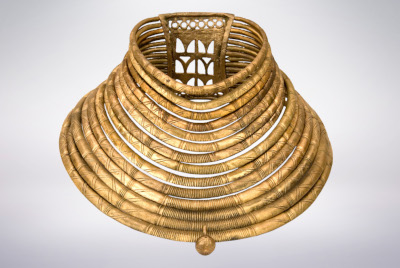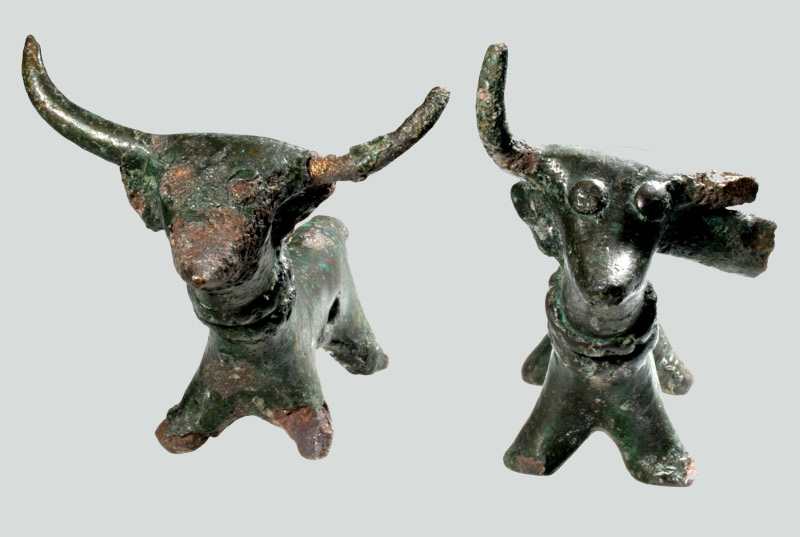Exhibitions
Departments
First-ever gold rush, barrows of mysterious rulers and their treasures
An alloy of copper and tin, bronze has been known as a raw material for making various objects since the 4th millennium BC. The invention of bronze was made, in all probability, in the Middle East, wherefrom it reached Europe in the late 3rd millennium BC. It did not take long to spread over modern Poland’s western regions, including the Warta River drainage. A large portion of Greater Poland found itself under the influence of a culture that had risen in Bohemia, Moravia and Lower Silesia, known as the Unětice culture (named after the town of Unětice in the Czech Republic). This culture’s populations played a significant role in the cultural development of a considerable portion of central Europe. It was here that a strong centre of bronze metallurgy developed, which used local deposits of copper and tin, and produced its own characteristic bronze objects, e.g. triangular daggers and halberds. The development of metallurgy and the growing demand for the components to make bronze alloys and ready-made bronze objects contributed to the greater exchange of goods. Societies settling Greater Poland then were part of the exchange as the region was crossed by several trade routes. The demand for the new metal, hitherto unknown, continued to grow, which resulted in the rise of local bronze workshops. The new stage of development of local societies, known as the Early Bronze Age, saw the inception of the specialization process whereby separate trades emerged (as, for instance, metallurgy). New types of societies were gradually taking shape such as, for instance, stable and economically self-sufficient kin groups of the Bruszczewo-Łęki Małe type. A major element of the then cultural landscape was a fortified central settlement accompanied by a cemetery, featuring barrow graves.
Metal casting workshop. Copper and tin were melted in clay crucibles to be poured afterwards into casting moulds made of clay or stone. Two methods of casting bronze objects were used. The first employed stone shell-type moulds that could be used many times while the other used one-off moulds that had to be destroyed as a result of the lost wax technique. The technique requires that a future object (bracelet, armlet or necklace) be modelled in wax first and next covered in clay and burnt in fire. Melted wax pours out through an opening left in the clay mould, while the burnt clay takes on a permanent shape. Next, through the same opening, molten metal is poured into the mould. An object cast in this way was removed from the mould by breaking it. Many objects cast in such moulds required further mechanical working, for instance, removing casting seams or deepening or cutting ornament patterns. Seams and uneven places were probably removed with hone stones, while precision working was performed with bronze stamps of narrow, chisel-like points.
The manifestations of social differentiation in the Early Bronze Age, monumental earthen barrows are conventionally called ‘princely’ graves. In centrally located stone grave chambers, members of the local social elite must have been interred. The best known features of this type include barrows at Łęki Małe, Kościan district, (four of them have survived until now) and the barrow from Grabonóg, Gostyń district, presented in the exhibition.
Apart from the monumental size of barrows, the remarkable position of people buried in them is reflected in grave goods, especially the so-called halberds, which are interpreted as insignia of authority (they were found in graves at the cemetery in Łęki Małe), as well as daggers.
The only of its kind in the lands of today’s Poland, a find of copper artefacts, known as the Bytyń hoard (Szamotuly district), was made by chance in 1873 by the workers who attempted to break up a boulder, lying in a field. Underneath it, at the depth of about 70 cm (2 ft), they found a figurine depicting a pair of oxen and six flat axes, of which four are shown in the exhibition.
The majority of bronze objects found in Greater Poland were part of group finds, known as hoards. They contain weapons, tools and ornaments. Among the most precious are hoards from Granowo, Grodzisk Wlkp. district, and Poniec, Gostyń district.
| < |
Bronze Age and the dawn of Iron Age>> |
Nasza strona internetowa używa plików cookies (tzw. ciasteczka) w celach statystycznych, reklamowych oraz funkcjonalnych. Dzięki nim możemy indywidualnie dostosować stronę do twoich potrzeb. Każdy może zaakceptować pliki cookies albo ma możliwość wyłączenia ich w przeglądarce, dzięki czemu nie będą zbierane żadne informacje. Dowiedz się więcej jak je wyłączyć. OK, Rozumiem



